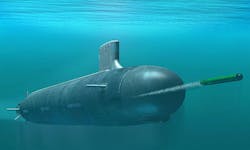MIKEL researchers helping Navy with submarine machine automation and combat system development
WASHINGTON, 11 May 2015. A Massachusetts research company is moving forward on a U.S. Navy project to design futuristic submarine combat system technologies involving machine automation and reduced manning requirements.
Officials of the Naval Sea Systems Command awarded a $6.7 million contract modification last week to MIKEL Inc. in Fall River, Mass., for research and combat system development and processing for Navy submarines.
MIKEL engineers will build on research they have been doing over the past five years in to improve submarine automation, reduced manning requirements, and improved human system integration over current submarine combat systems.
MIKEL, an undersea warfare systems specialist, is focusing on automation and data fusion, target motion analysis, weapon employment tactical decision aids, tactical combat and surveillance system algorithms for sonar, combat control, weapons, communications, command and control, and navigation for future Navy submarines.
Related: General Dynamics to upgrade COTS combat system computers on U.S. and Australian submarines
The most recent contract, awarded Thursday, continues MIKEL efforts that began in late 2010 and have involved contracts and orders worth $42.5 million on advanced submarine combat system and surveillance research.
The original contract, for $9.1 million, was awarded on 30 Dec. 2010, and was followed by contract modifications involving a $9.1 million order in January 2012, an $8.9 million order in September 2012, a $6.7 million order in March 2014, and the $6.7 million order last Thursday.
MIKEL has expertise in acoustic tracking and navigation, combat systems, and performance assessment. The company develops algorithms that process data, and delivers software and hardware systems for submarine and other military combat systems.
Examples of the MIKEL's expertise include the company's Automated Contact Management System (ACMS), a new approach to generating the tactical picture from the raw acoustic data from submarine sensors. This approach eliminates the need for traditional dot stacks, company officials say.
Related: Lockheed Martin to upgrade electro-optical imaging systems for Navy submarine fleet
The MIKEL Active Intercept and Ranging System (AIRS) seeks to determine the 3-D position to detected submarine active emissions at long ranges using existing submarine sonar systems for torpedo evasion and collision avoidance.
The company's Submarine Acoustic Navigation System (SANS) calculates the position of a submerged submarine or unmanned underwater vehicle (UUV) in real time using one bottom-mounted beacon emitting a synchronized coded ping.
This technology is for affordable submarine and UUV navigation, waypoint position updates, correcting the accumulated errors of onboard inertial navigation systems, and for exercise reconstruction.
For more information contact MIKEL online at www.mikelinc.com, or Naval Sea Systems Command at www.navsea.navy.mil.

